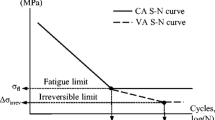Conclusions
This research has proven the feasibility of the application of FDT and DC subtraction to corrosion fatigue modeling. An accurate model was created, and experiments were used to find the best dynamic heat pattern to detect the corrosion. This research should be followed with measurements to determine the error associated with heat dissipation around the corrosion which hinders detection. This, along with temperature measurements on the specimen, will lead to a scheme of corrosion quantification.
Similar content being viewed by others
References
Chang, J., “Aging Aircraft Science and Technology Issues and Challenge and USAF Aging Aircraft Program”, ASME Winter Annual Meeting, San Francisco, CA, 1995.
Morrey, B., Biological, Material, and Mechanical Considerations of Joint Replacement, Raven Press, New York, NY, 1993.
Boyce, B., Lesniak, J., “Forced-Diffusion Thermography”, Non-destructive Inspection of Aging Aircraft, SPIE Vol. 2001, pp. 92–102, 1993.
Bazile, D., Private Communication, Stress Photonics Inc., Madison, WI, January, 1997.
Author information
Authors and Affiliations
Rights and permissions
About this article
Cite this article
Hermanson, K.S., Sandor, B.I. Corrosion fatigue modeling via differential infrared thermography. Exp Tech 22, 19–21 (1998). https://doi.org/10.1111/j.1747-1567.1998.tb01279.x
Published:
Issue Date:
DOI: https://doi.org/10.1111/j.1747-1567.1998.tb01279.x




